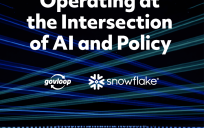This article is an excerpt from GovLoop’s recent guide, “Emerging Tech in Government: What It Means for Your Career.” Download the full guide here.
Artificial intelligence is the ability of computers and algorithms to learn on their own to perceive things around them and to act using data. AI has been around for decades, but public and private organizations are finding new ways to supplement human insights with machine intelligence.
As the President’s Fiscal 2019 Budget stated: “Agencies will continue to examine their workforces to determine what jobs they need to accomplish their mission, taking into account the impact of technological investments that automate transactional processes, artificial intelligence that can streamline the byzantine compliance and regulatory processes, online and telephone chat-bots to improve customer service, and other such tools that may reduce agency personnel needs.”
We’ve compiled several case studies that show how AI has begun to impact the public sector.
Automating Mundane Tasks
Bureau of Labor Statistics employees process millions of data points every month, including survey responses about workplace injuries and illnesses that are used to identify preventative measures. To process data more efficiently, accurately and consistently, the agency turned to AI.
One year, the agency received more than 2,000 distinct job titles to represent janitors or cleaners who have been injured on the job, William Wiatrowski, Deputy Commissioner at BLS, said during a recent event hosted by the Partnership for Public Service and IBM’s Center for the Business of Government. Trying to manually slot all those responses into one category was tedious. In fact, 80 percent of the surveys never used the words janitor or cleaner.
Despite the growing use of AI to do these and other coding tasks, the technology still has limitations. Machine learning couldn’t solve every problem, Wiatrowski said. BLS still relied on the smarts of its employees to address the most difficult cases.
Improving Grant Management
The National Institutes of Health — more specifically, the agency’s grants side — is also using AI. NIH undertakes a massive effort to sort spending across hundreds of categories. To do this, it creates a catalog of about 500,000 projects and categories each year to report publicly, said Richard Ikeda, Director of NIH’s Office of Research Information Systems.
“To do this manually would take about 700 full-time equivalents, but we do it in an automated fashion with text mining with about 10 percent of the expense of the manual effort that is required,” Ikeda said.
Right now, it is a rules-based text mining system, which means that employees establish the categories manually. A set of rules allows research and projects to be properly categorized. But NIH is experimenting with machine learning to train the system to handle these types of tasks, particularly when it comes to categorizing similar projects.
Streamlining Government-to-Citizen Interactions
As virtual personal assistants and smart speakers grow in popularity, state and local governments are using these technologies to better connect with citizens.
For example, Indiana is among a growing number of state and local governments that use Amazon’s Alexa, a digital assistant built into the company’s Echo product, to make information more readily available to the public.
In February, the Hoosier State released an update to its Amazon Alexa skill that enables residents to easily find current travel advisories by county and locate contact information for more than 20,000 government employees. To search for travel advisories, users say, “Alexa, ask Indiana for travel advisories.” Users can ask for the status of a specific county when making the request. If a county isn’t named, Alexa will ask for one.
Alexa users can also request contact information for thousands of government workers. Using the employee’s first and last names, they can quickly learn what agency they work for and their job title, phone number and email address.
New features will be added to the skill regularly to streamline government-to-citizen interaction.
Artificial Intelligence By the Numbers
- Currently available technologies could automate 45 percent of the activities people are paid to perform.
- Although its use is expected to grow, AI that is as intelligent as a human is not expected to occur in the next 20 years.
- Automation of federal government employee tasks could save 96.7 million to 1.2 billion hours annually and $3.3 billion to $41.1 billion, respectively.





I’m interested to see how newer versions of automated customer service reps are performing. I hate using them because it feels like you’re not progressing and I always end up pressing 0 to speak to a live agent. But if they can eventually do other tasks beyond basic ones it would be a huge improvement.